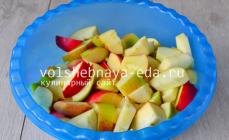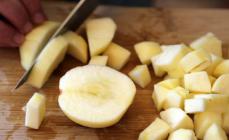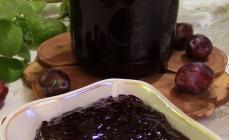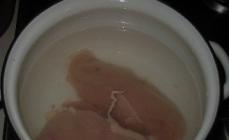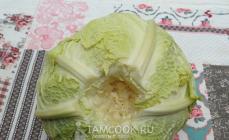Potato soup with pasta №18 / 2
Name of dishes: Potato soup with pasta
№18/2
Type of processing: Cooking
|
Product (semi-finished) |
Gross, G. |
|
|
Pasta |
||
|
Potatoes |
||
|
Carrot |
||
|
Vegetable oil |
||
|
Salt food iodic |
||
|
Bouillon meat |
|
Carbohydrates, G. |
|
|
Calorie, kcal |
|
|
Cooking technology |
|
Purified carrots and onions are cut with straw and allowed with the addition of water (20% to mass) and oil. The purified potatoes are cut by cubes, lay in boiling water or broth and boil 7-10 minutes, then add vermicells or noodles, sweened vegetables, salt and boil 7-10 minutes. until readiness. When vacationing in the soup, you can add fine greens (1-2 g). Organoleptic performance indicators Appearance - on the surface of the sequin fat, vegetables and vermicels (noodles) retain the form. Color - liquid part - light cream, vegetables and pasta characteristic of their kind. Consistency - pasta and vegetables are soft, ratio of liquid and dense parts. The smell is peculiar to boiled products included in the recipe, without outsider. The taste is characteristic of boiled products included in the recipe. |
Potato soup with cereal №16 / 2
/Products/programs.php?section_id\u003d123&element_id\u003d917
Name of dishes: Potato soup with cereal
Technological card (culinary recipe) №16/2
Type of processing: Cooking
Reception (Product Layings) for 1 Breaking Gram Net Dish:
|
Product (semi-finished) |
Gross, G. |
||
|
Potatoes |
|||
|
Rice croups |
|||
|
Carrot |
|||
|
Vegetable oil |
|||
|
Salt food iodic |
|||
|
Bouillon meat |
|||
Nutritional value, calorie and chemical composition of dishes (vitamins, trace elements):
|
The name of the indicator calculated in accordance with the new Sanamp |
|
|
Carbohydrates, G. |
|
|
Calorie, kcal |
|
|
Cooking technology |
|
Purified carrots and onions are cut into small cubes and allowed with the addition of water (20% to mass) and oil. The potatoes are sliced \u200b\u200binto boiling water, add washed oat leaps, adjusted to half-preparation, then add-on carrots, onions and boiled up to readiness, salt adds at the end of the cooking. On vacation in the soup, you can add finely chopped greens (1-2 g). Organoleptic performance indicators Appearance - form of cutting potatoes, carrots and onions - cubes. Color - liquids - grayish brown, vegetables and cereals - characteristic of their appearance. Consistency - cereals and vegetables are soft, the ratio of the liquid and dense part corresponds to. The smell is peculiar to boiled products included in the recipe, without outsider. The taste is characteristic of boiled products included in the recipe. |
Soup noodles on chicken broth №20 / 2
![]()
Name of dishes: Soup noodles on chicken broth
Technological card (culinary recipe) №20/2
Type of processing: Cooking
Reception (Product Layings) for 1 Breaking Gram Net Dish:
|
Product (semi-finished) |
Gross, G. |
|
|
Pasta |
||
|
Carrot |
||
|
Butter |
||
|
Salt food iodic |
||
|
Chicken broth |
Nutritional value, calorie and chemical composition of dishes (vitamins, trace elements):
|
The name of the indicator calculated in accordance with the new Sanamp |
|
|
Carbohydrates, G. |
|
|
Calorie, kcal |
|
|
Cooking technology |
|
Vegetables are cleaned, the potatoes are cut by structures, carrots and onions on the straw. Sliced \u200b\u200bcarrots and onions are allowed with the addition of broth (20% to mass) and oil. Potatoes are sliced \u200b\u200bin boiling chicken broth, boil 7-10 minutes, then add pasta, sweetened vegetables, salt and boil until readiness (7-10 min.). When vacationing in the soup, you can add fine greens (1-2 g). Organoleptic performance indicators Appearance - on the surface of the gloss, vegetables and pasta have retained the form. Color - broth - amber, dense part - peculiar products included in the recipe. Consistency - pasta and vegetables - soft, ratio of liquid and dense. The smell is characteristic of chicken broth and vegetables, without outsiders. Taste - characteristic chicken broth, vegetables and pasta. |
Milk soup with noodles №21 / 2
Name of dishes: Milk soup with noodles
Technological card (culinary recipe) №21/2
Type of processing: Cooking
Reception (Product Layings) for 1 Breaking Gram Net Dish:
|
Product (semi-finished) |
Gross, G. |
|
|
Milk |
||
|
Pasta |
||
|
Drinking water |
||
|
Butter |
||
|
Sugar |
||
|
Salt food iodic |
Nutritional value, calorie and chemical composition of dishes (vitamins, trace elements):
|
The name of the indicator calculated in accordance with the new Sanamp |
|
|
Carbohydrates, G. |
|
|
Calorie, kcal |
|
|
Cooking technology |
|
Pasta is put in boiling salted water (in a ratio of 1: 6), 5-10 minutes are boiled, then folded on the colander, give a track of water and put into boiling milk with water, sugar, salt, boil, boil 3-5 minutes, at the end Cooking lay butter and brought to a boil. Organoleptic performance indicators Appearance - on the surface of sequins of fat, pasta are not worn. Color - liquid part - light cream, pasta - white. Consistency - pasta - soft, tight and liquid ratio. The smell is peculiar with boiled pasta with milk and butter, without outsiders. The taste is characteristic of boiled pasta with milk and butter, sweetish. |
Name of dishes: milk porridge rice
Technological card (culinary recipe) №22/2
Type of processing: Cooking
Reception (Product Layings) for 1 Breaking Gram Net Dish:
|
Product (semi-finished) |
Gross, G. |
|
|
Milk |
||
|
Drinking water |
||
|
Butter |
||
|
Sugar |
||
|
Salt food iodic |
Nutritional value, calorie and chemical composition of dishes (vitamins, trace elements):
|
The name of the indicator calculated in accordance with the new Sanamp |
|
|
Carbohydrates, G. |
|
|
Calorie, kcal |
|
|
Cooking technology |
|
The rice cereal is washed and boiled in salted water until half-boiled milk, then hot boiled milk, salt, sugar and boil until prepared, at the end of the cooking is laying butter and brought to a boil. Organoleptic quality indicators Appearance - on the surface of the sequin fat, the croup is not rob. Color - liquid part - light cream, cereals - white. Consistency - cereals are soft, the ratio of the dense and liquid part corresponds. The smell is peculiar to boiled rigs with milk and butter, without outsiders. Taste - characteristic boiled rigs with milk and butter, sweetish. |
Topic number 6.
Cooking soups and broths
42 hours.
1. Preparation of chicken broth. Dairy soup with rice.
Studying flour passion techniques, vegetables.
2. Cooking soup Harcho, sweet soups. Compilation
technological cards with a single portion.
3. Preparation of soup, (from vegetables and chicken).
4. Preparation of potato soup with rice and soup
potato with pea.
5. Preparation of boors.
6. Preparation with fresh cabbage. Okroshka.
Cooking Solonov.
Maintenance objectives:
Understand the terms related to the preparation of soups and their classification.
To form practical skills on organizing jobs in the soup branch of the hot shop.
Examine the sequence of performing technological operations when cooking soups.
To learn how to work with regulatory and technological documentation, the definition of taste, dishes, compliance with the rules of filing, storage conditions and implementation periods.
Rail up the student culture of behavior at the table.
Characteristics of soups and their classification.
Soups - Liquid Kushanye, is a decoction of meat, fish, mushrooms, etc. With seasoning from vegetables, croup, etc.. To soups also include soup and borschy.
Soups are important part of lunch. They consist of two parts: liquid- basics and dense- garnira. Broths, milk and dairy drinks (kefir, prostow), decoctions from croup, vegetables, fruits, kvass are used as a liquid base. For the side dish, vegetables, mushrooms, cereals, legumes and pasta, bird fish, meat, etc.
Bouillon
-
a decoction obtained during cooking in the water of meat, bones, birds, fish, mushrooms, vegetables, fruits, etc.
Soup compartment is designed to prepare the first meals.
The technological process of cooking first dishes is divided into two stages: preparation of broths and cooking soups.
According to the method of preparation
:
filling; transparent; masculine (soups puree); sweet; Cold and others.
In addition, depending on the basis of the soups, there may be on the champions (broth) or on milk (dairy).
Filling
soup
call soups, when cooking in broth, mushroom brave booster to prepared vegetables, potatoes, cereals, legumes, pasta. These soups are filled with packed vegetables.
Transparent
Soups
designed to excite the appetite, as they contain a large number of extractive substances. Calorie transparent soup soups.
Transparent soups consist of transparent broths and garnings that are prepared separately.
Puree
Soups (soups puree)
they have a high nutritional value, they are easily absorbed by the body, so widely used in children's and therapeutic nutrition. These soups are prepared from vegetables, croup, legumes, birds and game, liver, fish. Distinctive
a peculiarity of soup-purees is that for their preparation, products are wiping, therefore soups have a homogeneous and gentle consistency. The base for soup-purees serve as mashed products and white sauce.
Soup-puree, as follows from their very name, have a puree consistency. Prepare them from vegetables (potatoes, carrots, turnips, white and cauliflower, zucchini, tomatoes, etc.), mushrooms (white, smurrchkov, champignons), croup and legumes (rice, oatmeal, green peas, etc.), meat Products and birds (liver, chickens, game), crayfish and less-
from fish products on meat, mushroom, fish broths and vegetable permeals.
Sweet soups
known in Russia with deep antiquity. They prepare them on the basis of compotes from fresh, dried, frozen fruits and berries. You can use the wipe fruits and canned fruit-berries puree. Served not only in cold, but also hot with sour cream or cream.
Unusually peculiar and unique Russiancool soups
cooked on kvass, beet and fruit decoctions, and Tayuk cool borschy. Prepared these soups in a cold shop using specially selected dishes, inventory and boards with appropriate labeling. Finished soups are stored in the refrigerator.
Dairy soups
prepare on whole milk, on a mixture of milk and water, and a tayuk made of milk milk and a condensed milk without sugar. These soups are prepared with croups, pasta and vegetables.
Soups are classified as follows: For feed temperatures: cold (10-14 degrees), hot (75-80 degrees).
Preparation of broths.
The taste quality of the broth depends on the ratio of water in itand
product, degree of shredding, cooking duration.
to prepare a normal broth on1
cG product take4...5
l water, and for concentrated1,25
l. From 1.
kg of product should water1
l concentrated broth.
to obtain normal broth1
l concentrated broth dilutedZ.4.l hot water and bring to a boil.
For cooking
Bone Broth:
prepared bones lay on the boiler,
one water in the ratio4,5 ... 5
l. 1
kg bones;
conduct to boil, remove foam. Boiled with a weak boiling with a closed lid, removing foam and fat from the surface;
bouillon from beef bones cook4
h, pork and calf - 2-3 hours
per 40... 60 min Before the end of the cooking, baked aromatic roots, carrotsand onion;
ready broth is filled through a sieve.
For cooking
measproof broth:
use: Beef Tow-
the bladder and sublock part, sneaker and crochemia, in a carcass of smaller livestock shovel and sneaker;
boiling broth boiling;
per 2... 2,5
h Before the end of the cooking, the blade and sublock part of the beef mass1,5...2
kg, breast -
before Z.kg
per 40... 60 min Before the end of the cooking, baked aromatic roots, carrots and onions are laid;
ready broth is filled through fine sieve.
For cooking fish broth:
1)
use food waste of fish sturgeon fishing, bones, fin, leather and cartilage;
2)
prepared Food Waste Weight
cold water
H)bring to a boil, remove foam;
4)
boiled with low boiling with a closed lid for
min, removing foam and fat from the surface;
5)
laid raw aromatic roots and onions,varyat
60
min;
6)
ready broth filtering through fine sieve
cooking boulomb from the bird:
prepared products are poured with cold water, bring to a boil;
boiled with weak boil, removing foam and fat;
through 20... 30
min are laying baked aromatic roots and onions;
Cooked broth 1-2 hours
Ready broth filtering through fine sieve
Technology Preparation of dairy soup
Sketch
Technology implementation
1. Preparation of cereals
A rice pearl or a camp, to go through, rinse several times, fall asleep into boiling salted water and boiled up to half-ready for 5-7 min., Wrap it up onto a sieve and give a stance of water.
2. Preparation of milk
One-piece milk is filtered, poured into the dishes, bring to a boil
3 Cooking soup
First method
To boiling milk, pour a prepared barbell, add salt, sugar and boil until readiness
4. Cooking soup
Second way
In boiling salted water, lay the prepared croup, cook before softening, add hot milk, sugar and cook until readiness

Soup-puree cooking technology from various vegetables
Technology implementation
1. Preparation of broth
Cooking bone, (meat-binding),
chicken brothand
vegetable beam.
2. Preparation of products
Heat treatment
products-
cooking (chickens, potatoes, cauliflower, croup, legumes) or allowance (root, liver, fish).
Grinding boiled product in order to turn it into a puree
Using a metallic sieve.
The onions are shining straw and slightly passer on the creamy oil. Carrots, turnip cut, the turnips are scarked to remove bitterness, insert. Belococcal cabbage is shredy, covered, lie. Potatoes are cut into parts and boil. Green peas are allowed
3. Preparation of liquid base soup.
prepare a flour fat Passerovka, which is bred by a hot low-fat broth, and boil. The clerk of wheat starch is detained in the future the sedimentation of the grid product particles to the bottom of the dishes. In the puree from the croup containing a lot of starch, it is not necessary to introduce a flour passer.
4. Manufacture of white sauce.
Wheat flour passover with fat or without fat. Wheat flour packed together with cooked bone or chicken broth, fill with butter
5. Depreciation of the spion.
Raw yolks are placed in the dishes with a thick bottom, thoroughly stirred, gradually pour warm boiled milk or cream, boil down at temperatures70... 75
° C until thickening, then filter.
The soup is filled with a milk-egg mixture, creamy oil or cream.
After refueling soup soup can not be heated above 70
Technological card Preparation of Harcho soup.
Cooking technology
The meat is cut into pieces weighing 25-30 gr., Boiled 2 hours. Fullable onions, tomato paste pass. Rice croup rinse and dunk for 1 hour. Ready broth strain. In the broth laying pieces of meat, rice, passioned bow. Cook until readiness. At the end, tomato paste is added, spices, garlic bring to a boil. On vacation sprinkled with parsley.
Technology of preparation of "Sweet soup from a mixture of dried fruits"
Technology implementation
1. Preparation of products
Preparation of products. Dried fruits are sorted, sorted by types, washed, large apples and pears are cut into parts.
2. Preparation of fruit beam.
Prepared apples and pears are poured with water and boil 15 ... 20 min. Then the rest of the fruit, sugar, boil until softening.
3. Preparation of potato starch.
The stratch is diluted with cold water to the consistency of liquid sour cream.
4. Preparation of the sidebar.
Boil rice, sago, dumplings, dumplings with berries, pasta. Pudding and casserole prepare
5. Preparation of sweet soup
A diluted potato starch is administered to boiling fruit, with continuous stirring, they are brought to a boil, citric acid and sugar are added. Do not boil in order to avoid liquefaction.
6 Feed
The dining plate lay the side dish, pour su, put sour cream or cream
Cooking technology "Potato soup"
Preparation of bone, meat bouillons and mushroom beam. 2. Potatoes are processed, cut into cubes, slices or pars. Processed carrotsand parsley (root) cutcubes or strokes and passenger. The onions treated onion are cut by slices and passenger. Tomato mashed potatoes pass, treated fresh tomatoes cut and pass.
Into broth or water; Potatoes are laid, boiled 5 ... 10 min;
pastened parsley, carrots and onions are added; cook until readiness; Provided to taste, add spices.
When cooking, you can add a parsed tomato in prison or fresh tomatoes after bookmarking parseshed vegetables.
The scheme of the preparation of "Solyanka of the Meat Meat".

Cooking scheme "Booschy"

Technology Cooking bread kvass
Rye bread is cut into small pieces and dried in the roast cabinet before the formation of a roasted crust;
water boiled, cooled to 80 's, prepared crops are poured and left for 1.5...
2 hours for insteading, water is periodically mixed. As a result of insteading, the wort is obtained, which is drained and filtered; The grain wort, having a temperature of 23 ... 25 ° C, put sugar, yeast, diluted with wort, and put in a warm place for fermentation by 8 ... 12 hours, in the process of fermentation in the kvass, you can put raisins, cumin, mint. Cool and stored in a refrigerator or on ice.
Technology Cooking meat okroshki
Preparation of products. Z.
elena bow bold, part of the onion is triturated with salt until the juice appears, fresh cucumbers are cleaned from coarse and bitter skin, remove large seeds, cucumbers with thin skin are not cleaned. The treated cucumbers are cut into small cubes or straws; Eggs are boiled, cleaned, separated protein from yolk. Yolks wipe through the sieve, and the proteins cut into small cubesThe meat is boiled, cooled and cut into small cubes or straw;
bread kvass filler; Dill smallly cut. Boiled egg yolks are triturated with a finished mustard, salt, sugar and part of sour cream, are connected to a green bow, mounted with salt, gradually when stirring is bred by bread kvass and put in the refrigerator.
Passing roots are injected, bow
Boiled 10-20 min
For 5-10 minutes, tomatoes are introduced or pastened tomato puree
Passing flour divided broth, spices
We leave with sour cream, greens, pieces of meat
TECHNICAL AND TECHNOLOGY CARD № BULON chicken with noodles, portion
- APPLICATION AREA
This technical and technological card is developed in accordance with GOST 31987-2012 and applies to the dish Chicken broth with noodles, portion generated by the catering catering.
- Requirements for raw materials
Food raw materials, food and semi-finished products used for cooking must comply with the requirements of existing regulatory documents, have accompanying documents confirming their safety and quality (certificate of conformity, sanitary and epidemiological conclusion, certificate of security and quality, etc.)
- Reception
| Name of raw materials and products | Units. | Consumption of raw materials I. | ||||
| products on | ||||||
| by 1 pore | ||||||
| Gross | Net | |||||
| Chicken broth with / p | ml | 200,000 | 200,000 | |||
| Fillet of the hip breed without leather | g. | 40,000 | 40,000 | |||
| Spaghetti boiled s / r | g. | 30,000 | 30,000 | |||
| Carrot Purified with / R " | g. | 20,000 | 20,000 | |||
| Salt cooking extra | g. | 1,000 | 1,000 | |||
| Pepper black hammer | g. | 1,000 | 1,000 | |||
| Egg chicken table 1 cat | pC | 0,250 | 0,250 | |||
| Dill p / f " | g. | 2,000 | 2,000 | |||
| Spices from / p | pore | 1,000 | 1,000 | |||
| Dishes exit (in grams): | 300 | |||||
- TECHNOLOGICAL PROCESS
Broth and spaghetti are prepared according to layouts. Carrots thick 3-4mm and chicken cut with slides with a thickness of 6-7mm.
Carrots are added to the boiling broth (vegetables are prepared until prepared so that the carrots are soft), bring to a boil.
A chicken is added (plus chicken from broth 25 g), heated. Conduct to taste with spices. Boiled spaghetti
(Sliced \u200b\u200b5 cm), poured with broth with vegetables.
Decorate with greens and fourth eggs.
- Requirements for registration, implementation and storage
Feed: The dish is prepared by order of the consumer, used according to the primary dish formulation. Storage and implementation period according to SanPiN2.3.2.1324-03, SanPine2.3.6.1079-01 Note: The technological card is compiled on the basis of an act of study.
- Quality and safety indicators
6.1 Organoleptic quality indicators:
Appearance - characteristic of this dish.
Color - characteristic of products included in the composition.
Taste and smell - characteristic of products that are part of the product, without extraneous tastes and smells.
6.2 Microbiological and physico-chemical indicators:
On microbiological and physicochemical indicators, this dish meets the requirements of the technical regulation of the Customs Union "On Food Safety" (Tr Ts 021/2011)
- Food and Energy Value
Engineer-technologist.


